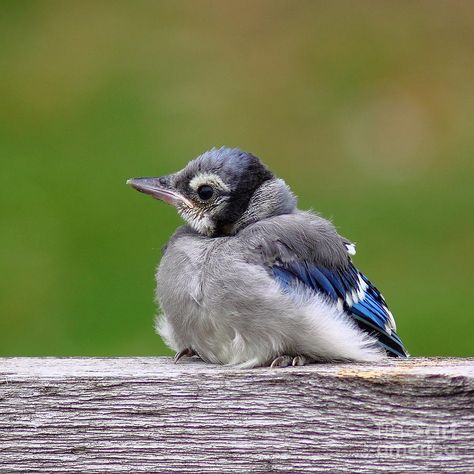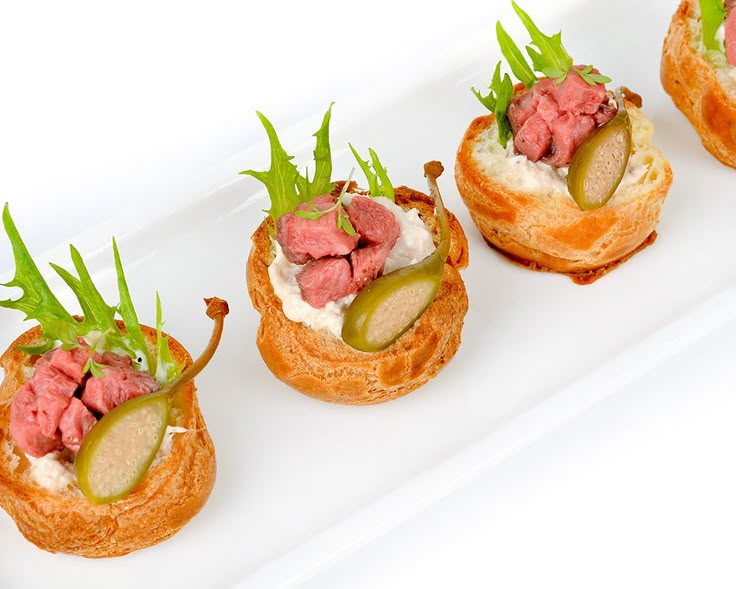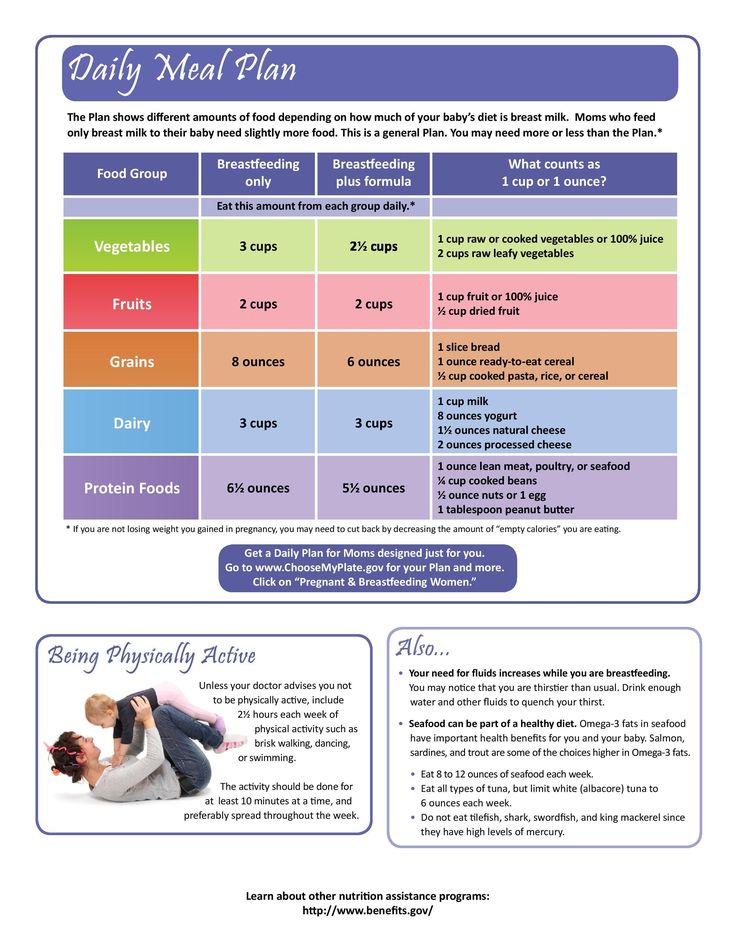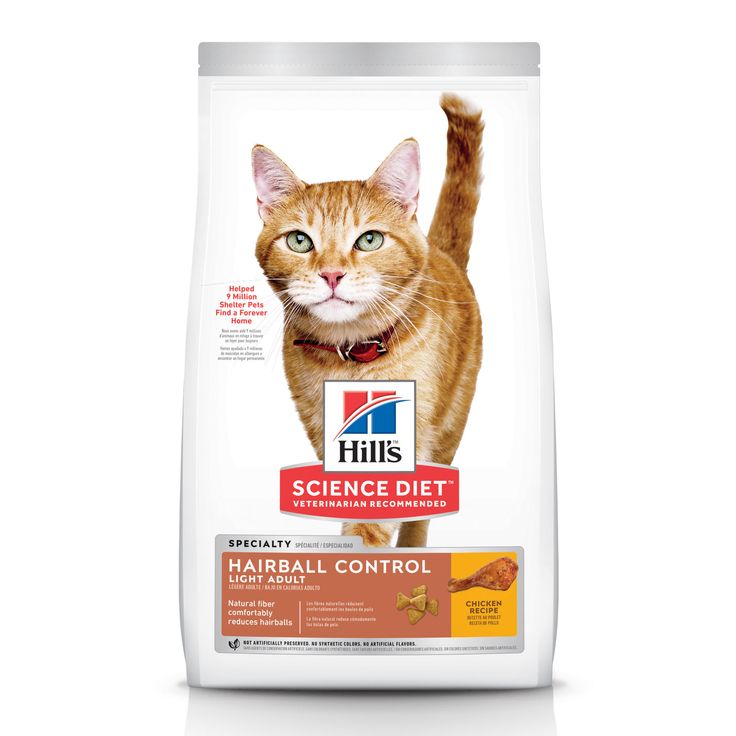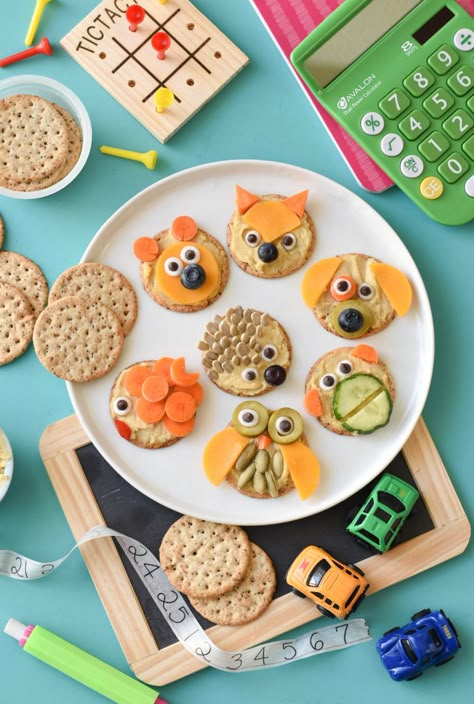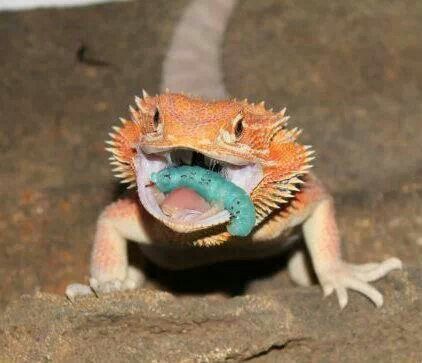What to feed baby bluebirds
Bluebird Parental Care of Hatchlings, Nestlings, and Fledglings
Bluebird eggs hatch within a period between 24 to 50 hours. Chicks hatch blind and naked.
Both parents take care of the young and feed them with a diet rich in proteins, mostly insects.
Nestlings grow fast and leave the nest in about 16 to 25 days, depending on the region. After they fledge, parents continue taking care of the fledglings for about three weeks until they become independent.
How long does it take for bluebird eggs to hatch?
The incubation period is variable within the Bluebird’s ranging between 11-19 days with an average of 13.5 days. Bluebirds in the warmer southern states have slightly shorter incubation periods than those in colder northern regions.
The female Bluebird starts incubating the eggs on the last or day before last she lays the last egg. She lays one egg every day but does not sit on them.
The female does all the incubation of the eggs. Once the egg hatch, she broods the nestlings continuously until approximately day 5-7 after hatching, when the nestlings begin to have some thermoregulatory control over their body temperature.
The male is always around, bringing food to the female while she incubates the eggs. Then, the male also brings food for the brooding female and the nestlings during the first days after hatching.
Egg hatching
Hatching begins 1 to 6 hours before the chick emerges completely from the egg.
The female incubates all the eggs for about the same period of time, ensuring that eggs hatch as close to each other as possible, eliminating the size advantage of chicks that hatch first over those that hatch last.
Blind and mostly naked.
Bluebird chicks at hatch are blind and mostly naked with patches of gray down. They weigh approximately 2.4 gr (0.08 oz).
Baby bluebirds are “altricial,” which means that nestlings are entirely dependent on their parents until they become nutritionally independent and can find food for themselves.
Both parents work equally to feed the chicks.
Both parents feed the chicks from day one, but the male does most of the work during the first five days after hatching. As in other birds, chicks open their mouth wide when they sense one of the parents in the cavity.
As in other birds, chicks open their mouth wide when they sense one of the parents in the cavity.
Studies of the breeding biology of nesting bluebirds indicate that both parents take about the same number of trips in and out of the cavity.
The same studies noted that the female alternates feeding with brooding the young birds during the first week as they cannot regulate their body temperature.
After a week, the young birds can regulate their body temperature, and the female does not have to brood them all the time, although she spends the night with them.
Parents appear to take more feeding trips and be more active during the early morning hours. The feeding continues in the afternoon but not as frequently as in the morning.
Foods fed to nestlings.
The parents bring crickets, spiders, grasshoppers, butterflies, and moth larvae, as well as berries such as raspberry, mulberry, dogwood, cherry, and honeysuckle.
The diet of nestling bluebirds is high in protein, consisting of approximately 68% invertebrates and 32% berries. A high protein diet helps chicks grow as fast as possible and leave the nest soon.
A high protein diet helps chicks grow as fast as possible and leave the nest soon.
Photo: Festive Coquette/Flickr/CC by 2.0
Nest sanitation.
Four to 5 chicks defecating in a small cavity would make a big mess, but both parents clean up the cavity throughout the day.
As it occurs in many birds, right after chicks are fed, these turn around to present the parent with a fecal sack or pellet. The fecal material is encased in a bag-like gelatinous packet the parent takes with its beak and drops far outside the nest.
When the chicks are very young, parents will eat the fecal sacks, but this practice ends as the chicks get older and are fed various food items.
If one of the chicks dies, one of the parents, when possible, pulls it out of the cavity and drops it outside the nest.
How fast do nestling bluebirds grow?
Bluebird chicks develop fast. After hatching, young bluebirds begin making calls loud enough to be heard when parents arrive with food.
Feathers begin to grow and replace the gray down by day 2. The nestlings open their eyes by days 5 and 6. By day seven, the chicks have short feathers on most of the body’s back and sides. By day 13, chicks are completely feathered.
By day 13 and older, male and female young bluebirds can be told apart based on their plumage color.
Leaving the nest comes next.
As with the onset of the breeding season, the age at which chicks leave the nest varies with latitude.
Bluebirds in northern portions of the species range start nesting later, take slightly longer to hatch, and appear to take a little longer to leave the nest than birds in southern states.
However, the difference is small.
Across the species range, young Bluebirds leave the nest between 16 to 21 days after hatching.
Because all chicks hatch at about the same time, size differences among chicks seldom develop. Chicks of the same age and size leave the nest simultaneously.
Parental care after fledging.
Parents and young bluebirds stay together after fledging for about three weeks.
After leaving the nest, young Bluebirds remain in a relative hide for the first week or so. The parents bring food to the fledglings, which are easily located by their persistent calls.
During the first week after leaving the nest, fledglings still depend entirely on their parents for food. They begin practicing flying from place to place.
After the first week, the young birds begin to follow the parents to more open spaces. The young Bluebirds also start performing the typical sit-wait-and-drop strategy to catch invertebrates.
As fledglings gain experience obtaining their food, the parents feed them less and less.
Once fledglings become nutritionally independent, they take trips further and further from the family unit after about three weeks.
Then, the young bluebirds join flocks of juvenile birds that move about in the region.
Field observations have noted that chicks hatched late in the summer may remain with the parents through the winter.
Overall, the time it takes for young Bluebirds to separate from their parents is variable.
Some fledglings stay in the family’s territory for a long time, while others join flocks of juvenile birds and leave the family unit in about three weeks.
Photo: Wendy /Flickr/CC by 2.0
In the event that one of the parents dies, what will happen to the eggs or nestlings?
The effect on the eggs or nestlings varies depending on when and whether the male or the female goes missing. This is because the male does not incubate the eggs nor brood the young.
Disappearance when the pair has eggs in the nest
When one of the parent bluebirds dies or disappears during the egg-incubating period, the nest fails, and the remaining parent is likely to find a new mate and start another nesting attempt. Males do not incubate eggs, and the female cannot incubate, brood, and feed the young without the help of a male bringing food to the nest.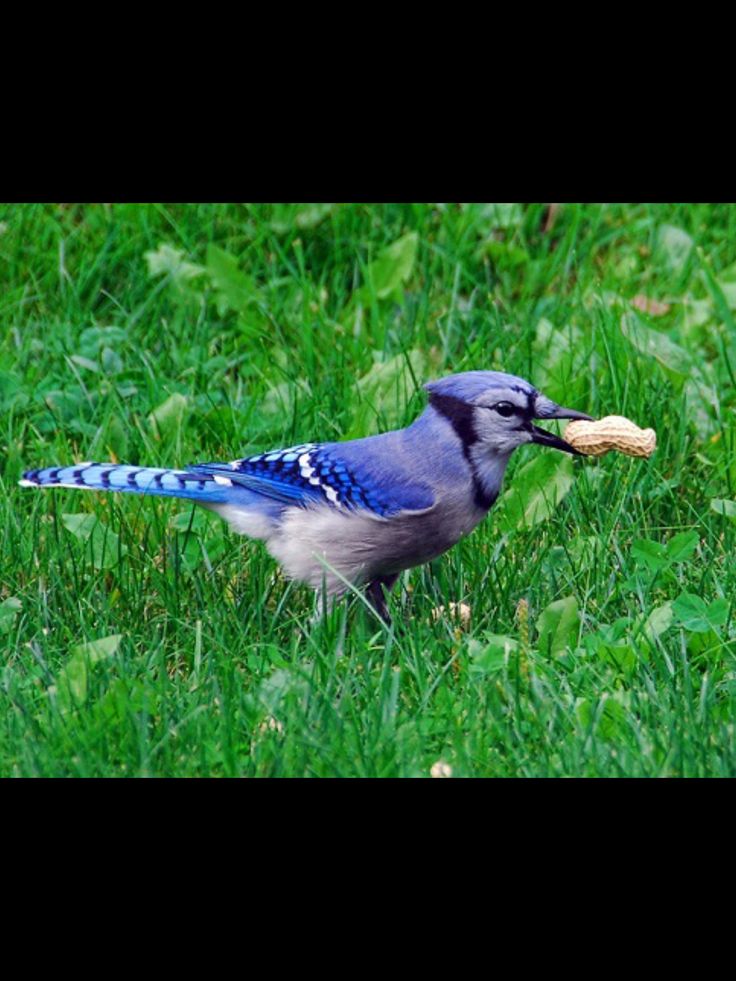
Disappearance when the pair has nestlings
When a parent dies or disappears when they have nestlings, the possible outcome depends on the age of the young bluebirds.
Generally, the remaining parent will try to get a replacement mate to help raise the brood.
Possible outcomes include:
- If the female disappears when the nestlings are less than 7-8 days old, the nestlings are likely to die because they are unable to thermoregulate their body temperature. While the male will continue feeding them, he does brood them at all. If the female disappears after the 8-12 days, the nestlings do not need brooding, and the male alone is likely to raise the brood on his own.
- If the male disappears when the nestlings are less than 7-8 days old or older, the female may be able to raise them alone, although she could fail.
Both the widowed male or female can enlist the help of a new partner that helps them raise the young. The new partner’s interest is acquiring a territory and having the next brood as a parent.
 New partners that begin as helpers do help but not as energetically as if they were the real parents of the brood.
New partners that begin as helpers do help but not as energetically as if they were the real parents of the brood. Helping a widow raise his/her young is a way for “floaters” to acquire a territory. A floater is an adult bluebird ready to breed but does not have a mate or territory.
Older siblings may help parents raise the new brood
Another observation of these studies was that young birds of the previous brood, still in the parents’ territory, may help feed their younger siblings.
This behavior appears not to be common and happens more often in certain habitat types and conditions than in others. The actual help older fledglings provide is also in doubt. It may be that young birds do this as a manner of practicing for when they become parents.
If one of the parents disappears and older fledglings are around, they are likely to help raise their younger siblings.
References:
- Eastern Bluebird, Life History. All About Birds.
 The Cornell Lab of Ornithology.
The Cornell Lab of Ornithology. - Gill, Frank (1995). Ornithology. New York: W.H. Freeman.
- Sialis Online. Bluebirds.
- The Birds of the World Online. Eastern Bluebird (Sialia sialis). Cornell Lab of Ornithology, Ithaca, New York.
LEARN MORE:
Feeding Bluebirds
Bluebird Feeding 101
During the warmer months of the year (May through October), Bluebirds can usually find enough food to survive without any problems. However, under harsh conditions such as prolonged period of chilly, wet weather, or snow & cold, or when ice coats most of the wild berries, bluebirds will benefit from receiving feeder food. Meal worms, suet, sunflower hearts, softened fruits, and cornmeal muffins can all be fed to bluebirds. Most of these will be accepted during the cold weather months if bluebirds have wintered over. But, meal worms are the best food to feed bluebirds and they will readily eat them year-round. During the breeding season, it is nice to feed meal worms because the harried parents will gratefully accept them to help feed their ravenous young. Basically, it acts as a supplement to the natural insect diet bluebirds feed their young.
During the breeding season, it is nice to feed meal worms because the harried parents will gratefully accept them to help feed their ravenous young. Basically, it acts as a supplement to the natural insect diet bluebirds feed their young.
NOTE: supplemental feeding can make a HUGE difference to Bluebirds and their young during periods in the Spring when rain and cool weather persists over multiple days. Bluebirds will have a hard time feeding their young when cool, wet conditions persist. If this happens, adults will stop feeding their young and focus on their own survival. So, you can help Bluebirds survive by feeding meal worms and even scrambled eggs. See below for details.
Meal Worms
Meal worms can be purchased at some bait shops, pet stores or bird supply stores. To order larger quantities, it is usually more economical to purchase meal worms online.
Meal worms are the larval stage of darkling beetles. Put a bedding of cornmeal or wheat bran into a plastic rectangular container with holes drilled or punched in the top for ventilation.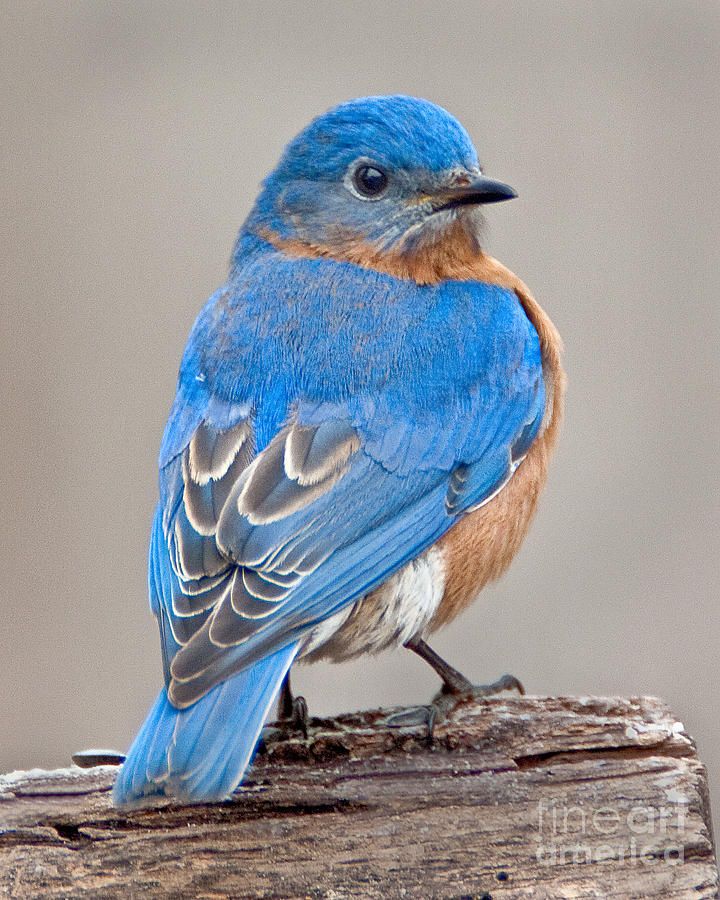 Add a piece of apple, carrot or potato for moisture. If you have a large amount of meal worms that you won't use right away, put the container in the refrigerator to keep them dormant so they don't turn into adult beetles.
Add a piece of apple, carrot or potato for moisture. If you have a large amount of meal worms that you won't use right away, put the container in the refrigerator to keep them dormant so they don't turn into adult beetles.
Meal worms can be served up in any type of shallow dish or container with smooth sides, so the meal worms can't escape. The feeding dish MUST BE made of either glass, plastic, metal, or ceramic because meal worms can crawl out of anything with rough sides (like wood). The problem is once other birds find the mealies (e.g. robins) they'll be gone in a flash. Meal worm feeders can be purchased at many bird supply stores. Some feeders have entrance holes which require birds to enter the feeder to get at the meal worms. This will discourage non-cavity nesting birds that are larger than bluebirds from eating up all the worms - after all, insects are popular with most birds!
Another meal worm feeding tip is to "train" the birds to find the meal worms in the same place, at the same time every day. The Bluebirds will figure this out quickly, and be waiting for you each day when you bring the worms out. Our experience has shown that early morning is the best time. Bluebirds are hungry then, other insects may not be active yet, and competition from other birds is less.
The Bluebirds will figure this out quickly, and be waiting for you each day when you bring the worms out. Our experience has shown that early morning is the best time. Bluebirds are hungry then, other insects may not be active yet, and competition from other birds is less.
For more information on feeding meal worms, Click Here to download the North American Bluebird Society's factsheet on Meal worms.
Online sources for meal worms:
Rainbow
http://www.rainbowmealworms.net/
Nature's Way
http://www.thenaturesway.com
BestNest
http://www.bestnest.com/bestnest/mealworms.asp
Scrambled Eggs
As previously stated, under severe conditions of cold and wet weather, bluebirds can be fed scrambled eggs. They will readily accept them and feed them to their young. Kurt Hagemeister of the Michigan Bluebird Society reports that this tactic saved a nest of young bluebirds several years ago in his yard. The eggs should be cooked as normal, scrambled, let cool, and then put out in a tray type of birdfeeder not far from the nest. If the birds don't eat them within a day or two, remove them from the area so they don't go bad or attract unwanted predators.
If the birds don't eat them within a day or two, remove them from the area so they don't go bad or attract unwanted predators.
Suet
Bluebirds will sometimes feed on suet. Since insects are plentiful in the summer, it will be difficult to get them to eat suet at that time of year. But as the weather gets cold and insects are scarce or non-existent, they will really eat up the nutritious and energy-filled suet that you provide for them. Commercially made suet cakes are easy and relatively inexpensive. Cakes with hulled sunflower, peanut bits, raisins, and ground up corn meal are very good.
Here is a great recipe that you can make to attract bluebirds:
Bluebird Suet Recipe
1 cup lard
1 cup crunchy peanut butter
1/3 cup sugar
1 cup whole wheat flour
2 cups oatmeal
2 cups cornmeal
1 ½ cup raisins
Put raisins in sauce pan and add water to cover. Bring to boil; remove pan from heat and let raisins cool.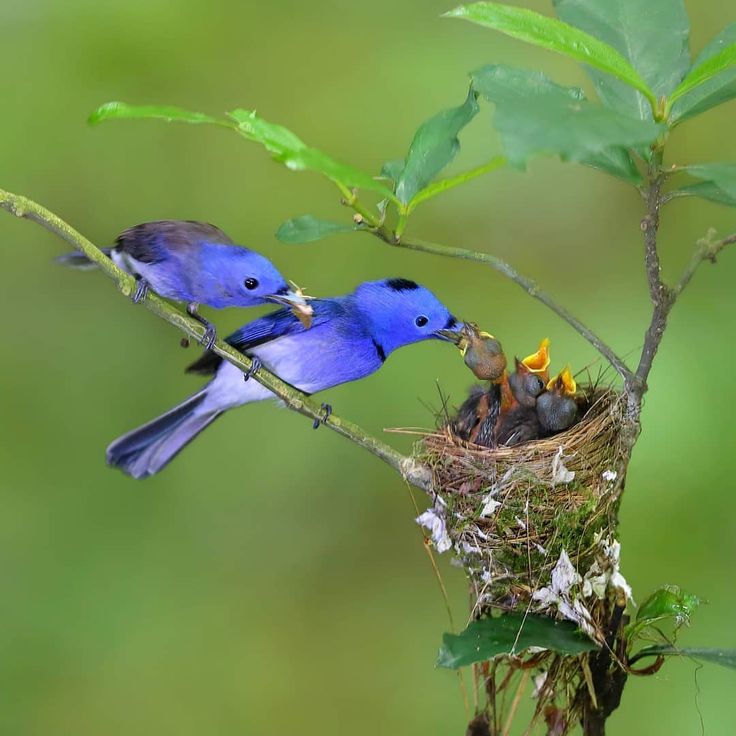 Drain water and cut raisins in half. Set aside.
Drain water and cut raisins in half. Set aside.
In a large mixing bowl, mix together flour, oatmeal and cornmeal.
In small sauce pan on low heat, melt lard, peanut butter and sugar. Pour liquid mixture into dry ingredients and mix well. Add raisins.
Seed And Other Foods
During the cold weather months, you can feed Bluebirds sunflower hearts, softened raisins, blueberries, and currants. Note that Bluebirds won't eat these other foods much except during the harshest of conditions. This typically occurs during late Winter or even early Spring, when the weather is still very cold and natural foods are running out. Otherwise, they will continue to eat mostly wild berries and other fruits they can find. It is best to put it in an open tray feeder or a special bluebird feeder which has openings at either end for the Bluebirds to enter.
The Jail Bluebird Feeder
A very good type of feeder is the Bluebird Jail feeder. This feeder (pictured at the right), was designed to exclude larger birds, such as Robins and Starlings, from getting at the mealworms or other food, before the Bluebirds can get it. The feeder is enclosed (which shelters the mealworms/food) with a dish in the middle for the food. The birds can either enter through the 1 1/2" diameter entrance holes on the ends or in between the wooden dowel "bars". Unlike some Bluebird feeders that have Plexiglass instead of the bars, the jail feeder is more open and makes it easier for the birds to get to the food. The trick to getting Bluebirds to start using the feeder is to leave the top open (and even remove the bars) temporarily until the birds "figure out" that there is food in there. Once they start coming regularly, replace the bars and close the top of the feeder. They should start entering through the ends or between the bars.
The feeder is enclosed (which shelters the mealworms/food) with a dish in the middle for the food. The birds can either enter through the 1 1/2" diameter entrance holes on the ends or in between the wooden dowel "bars". Unlike some Bluebird feeders that have Plexiglass instead of the bars, the jail feeder is more open and makes it easier for the birds to get to the food. The trick to getting Bluebirds to start using the feeder is to leave the top open (and even remove the bars) temporarily until the birds "figure out" that there is food in there. Once they start coming regularly, replace the bars and close the top of the feeder. They should start entering through the ends or between the bars.
The Gilbertson Bluebird Feeder
This feeder is another variation of the Jail Feeder shown above. It is also designed mainly to limit the size of birds that can get to the mealworms or other food to Bluebird-sized birds or smaller. So, again, Starlings and Robins will not be able to access the feeding area.
The Gilbertson feeder was designed by Steve Gilbertson of Minnesota. It is a very simple-to-build feeder that almost anyone with basic woodworking skills can make. It is primarily composed of 2x4, 1x10, and 2x2 cedar. There is also some short lengths of 1/8" diameter metal rod which is installed horizontally. This can be found at most hardware stores or home centers.
One of the bars is removable to allow access to the feeding area container. The plan calls for using an old aluminum or tin tuna fish can. You can also buy a small glass dish for this purpose. To download the plans for this feeder design, click below.
Gilbertson Feeder Plans
Bluebirds & Mealworms!
Watch this great video to see how attracted Bluebirds are to mealworms.
What can be fed to titmouse.
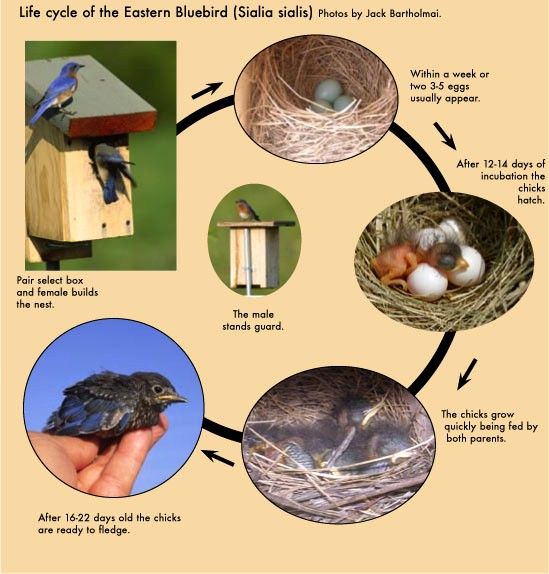 How to feed titmouse - nutrition of titmouse
How to feed titmouse - nutrition of titmouse Contents
- What can be fed to titmouse. How to feed titmouse - nutrition of titmouse
- Peculiarities of the diet of titmouse
- Allowed products for titmouse
- Prohibited products for titmouse
- Feeding titmouse in summer
- Feeding titmouse in winter
- Life of titmouse
- How to feed titmouse and other birds in winter
- How to feed birds in summer. Should I feed the birds in summer?
- What to feed little titmouse. How to feed chicks picked up by children on the street
- Chick schedule
- Chick menu
- Swallows are not returned to the wild
- How to feed tits at home. LET'S FEED THE TITS
- What does a chick look like. Tit chick: what does it look like and how to feed it?
- What grains can be fed to titmouse. What is recommended to feed tits in winter
- Bird feeders
- Optimum bird diet
- Prohibited food
- Permissible seeds and cereals
What can be fed to titmouse.
 How to feed titmouse - feeding titmouse
How to feed titmouse - feeding titmouse Beautiful birds are pleasing to the eye in winter, and in summer they fight insects. Small yellow bellies delight children and adults. What to feed the titmouse so that you can once again admire the winged creatures?
Features of the diet of tits
When they start feeding birds, the question arises, what do tits eat. The composition of the diet includes:
- Vegetable food - cereals. Oats, pearl barley, hercules are the basis of bird nutrition. Sunflower seeds are also used.
- Animal feed. Insect eggs, lard, meat products, cottage cheese (as a source of protein).
- Vitamin food. You can beautifully feed the tits in the feeder with the help of fruits, berries (dried and fresh, strung on a thread).
Allowed foods for titmouse
The most popular food for titmouse is seeds. But what else can you feed besides them? Simple solution: buy parrot food. The bird will be very happy with the treat.
If you don't know which cereal to choose, pay attention to the following types:
- millet;
- oats;
- millet;
- wheat;
- fig.
From animal products, tits can be fed in the city:
- eggs;
- cottage cheese;
- unsalted lard;
- sausage.
Among vitamin feeds, they can be offered dried fruits and berries.
Prohibited products for tits
Do not feed titmouse in the feeder:
- Roasted sunflower seeds. Cause liver problems in birds.
- Salty foods. Causes indigestion and stomach problems.
- Damaged products . Causes indigestion.
- Bread. It swells in the goiter and begins to ferment, causing the death of the bird.
Controversial questions often arise as to whether it is possible to feed millet tits, because toxic substances accumulate on the shell of the grain. In modern conditions, this is a rarity, but if you are still afraid for the life of a bird, pour boiled water over millet to flush out toxins.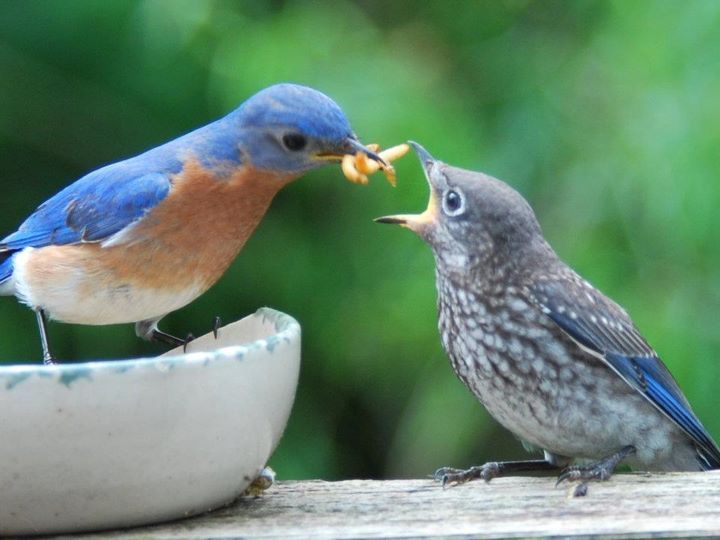
Do not feed blue citrus and exotic fruits yet. Birds have not consumed them before and therefore may die due to an allergic reaction.
Feeding tits in summer
Birds do not need additional feeding in summer, as they can get food in the form of plant seeds, insects, berries and fruits.
Feeding tits in winter
Feeding tits in winter can be up to 2 times a day. Put them in the feeder of seeds, oatmeal, millet, rice and they will be happy. You can please with cashew nuts, walnuts or cedar fruits.
In winter, the consumption of energy required for heating increases and it's time to feed the tits with fat. Choose not salty foods, but fresh ones.
You can also enjoy the "bird" pie, rich in animal and vegetable oils. To prepare it, pour a handful of sunflower seeds, pumpkins, peanuts, egg shells, dried berries with melted butter and cool. Feeding tits in winter with the resulting bar is easy and pleasant. Birds love this treat!
If you are wondering what to feed the tits, then you are a kind and responsible person.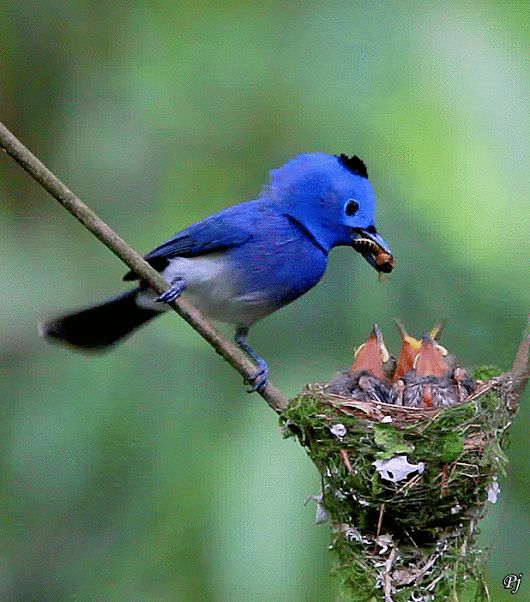 Learn to love nature in order to live in harmony with it!
Learn to love nature in order to live in harmony with it!
Life of titmouse in winter. What to feed titmouse and other birds in winter
In winter, many birds living in cities need additional food. What to feed titmouse and other birds? What can be poured into the feeders, and what will be harmful to the birds.
City birds - sparrows and pigeons are much better adapted to frost than birds that have flown into the city from the wild. According to statistics, 8 out of 10 tits die during the winter in cold weather. In sparrows or pigeons, this figure is much lower - 1-2 individuals die. That is why special attention should be paid to titmouse and other birds from the wild.
How to feed tits and other birds.
First you need to build a feeder and sow it on a tree, you can right next to the house. The feeder can be made from absolutely any material. Even juice bags, wood and more will do. The main thing is that the birds can fly into the feeder and peck at the food.
The diet of these colorful birds is different in summer and winter. In summer, tits feed on beetles, aphids, mosquitoes and midges. In winter, they switch to plant foods - seeds of spruce, birch, wheat, rye, etc.
In the city, you can feed the birds with seeds, various cereals, crushed nuts, dried berries and dried fruits. You can also buy special food for canaries and parrots. Wheat bread for tits is suitable only in the form of crackers and crumbs.
In addition to tits, other birds fly to the city, such as goldfinches, bullfinches and others. These birds should be fed in the same way as tits. After all, the stomachs of forest and field birds are quite sensitive to human food. Do not give birds salty and sweet food.
What to feed the birds in summer. Should I feed the birds in summer?
A recurring myth about bird feeding is that feeding birds in the summer makes them dependent on handouts or lazy in their search for natural food sources. This is simply not true—studies have shown that wild birds typically get no more than 25 percent of their daily food from feeders, and for many backyard species, the amount is even lower. In fact, summer is the perfect time to feed the birds because...
In fact, summer is the perfect time to feed the birds because...
- Long days give the birds in the backyard more time to watch the feeders and see many different hungry visitors.
- Birds are in their plumage during the summer months making identification easier and more enjoyable with bright colors and clear markings.
- Birds raise their families by giving backyard birds the opportunity to watch the chicks mature as they learn to visit feeders.
- There are many more birds in the northern areas during the summer months, and birds that only offer food in winter will miss many amazing species.
At first, it may seem that fewer birds visit the feeders in early or mid-summer, making the season less desirable for backyard poultry. In early summer, however, many birds nest and are naturally more secretive, and although their chicks are very young, these birds only visit feeders for a short time. In addition, this is the time of year when many natural food sources - fruits, insects, seeds, etc.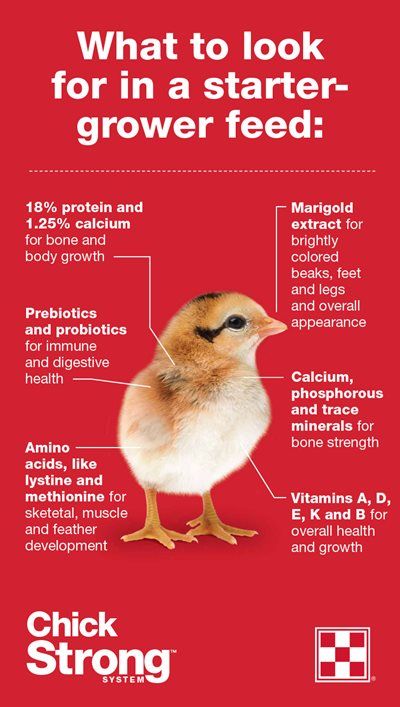 - become more available, reducing the use of bird feeders. Persistent birds, however, can enjoy more summer birds if their feeders are filled with nutritious treats.
- become more available, reducing the use of bird feeders. Persistent birds, however, can enjoy more summer birds if their feeders are filled with nutritious treats.
What to feed little titmouse. What to feed the chicks that were picked up by children on the street
Very often children bring chicks from the street that supposedly fell out of the nest, and begin to take care of them with tears. They arrange a nest in a box, lay it on cotton wool or rags and ask adults about what to feed the chicks that have fallen out of the nest?
Not every parent is capable of making the baby take the chick to where he brought it from, although he understands that he will have to take care of the foundling.
Chick mode
Chicks need food often, once every 15-20 minutes. It will be possible to interrupt only for a night's sleep and resume feeding should be no later than the sun rises.
What to feed the chicks depends on the type of birds they belong to.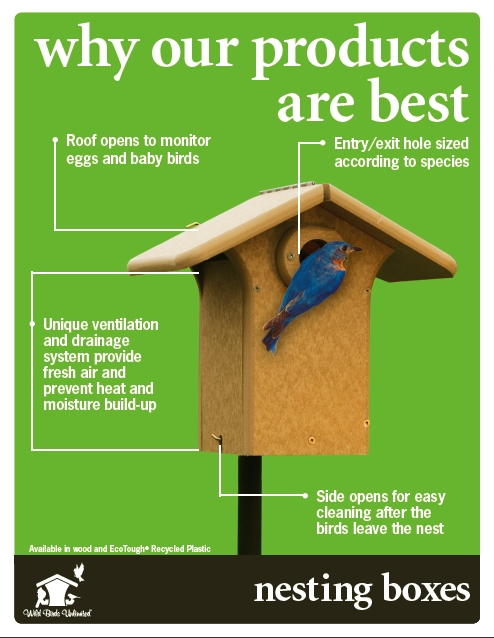 It is possible to feed a swallow, songbird, sparrow, swift, crow or dove at home. Almost all chicks can be returned to where they were found, and their parents will certainly take care of them.
It is possible to feed a swallow, songbird, sparrow, swift, crow or dove at home. Almost all chicks can be returned to where they were found, and their parents will certainly take care of them.
Only small swifts are not returned to their place. Swifts cannot help a chick that has fallen out of the nest, they cannot take off from the ground. You can distinguish a swift from a swallow by its paws - in swifts, all fingers look forward.
Chick menu
The children found a sparrow chick. What to feed the bird?
Despite the fact that adult birds peck grains with pleasure, the chicks are fed with protein food. Meal worms and live bloodworms are suitable for food, which can be purchased at pet stores, earthworms - you can dig them up yourself, flies - also caught with your own hands.
Feeding should ideally be done every 20 minutes - if not, at least once an hour. A piece of food must be pushed into the chick's beak, opening it by force. If you cannot get live food, then you need to mix pieces of egg yolk, cottage cheese and minced meat and make tiny balls.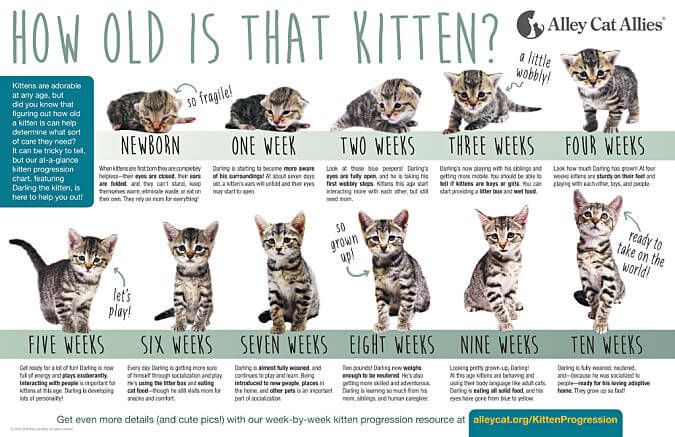 The chick itself does not know how to peck, but by 3-4 feeding it understands that it is required to open the "mouth".
The chick itself does not know how to peck, but by 3-4 feeding it understands that it is required to open the "mouth".
What to feed a titmouse chick? Its diet is no different from that of a sparrow. The only thing is that the tit chick may need mineral supplements and vitamins, which will have to be introduced along with the food. Chicks of tits are found less often; these birds hide their nests from people. It often happens that parents, frightened by people, lose a chick, and when the children find it, it is quite weakened.
Swallows are not returned to the wild
Children often bring small swallows home. These birds nest on the last floors of human dwellings and under balconies. What to feed the chicks of these birds? Swallows always feed on protein food, and therefore feeding swallows is no different from nursing sparrow chicks. But it must be remembered: if birds of other species during maturation are gradually transferred to grain feed and can leave hospitable hosts, a swallow fed in captivity does not return to freedom.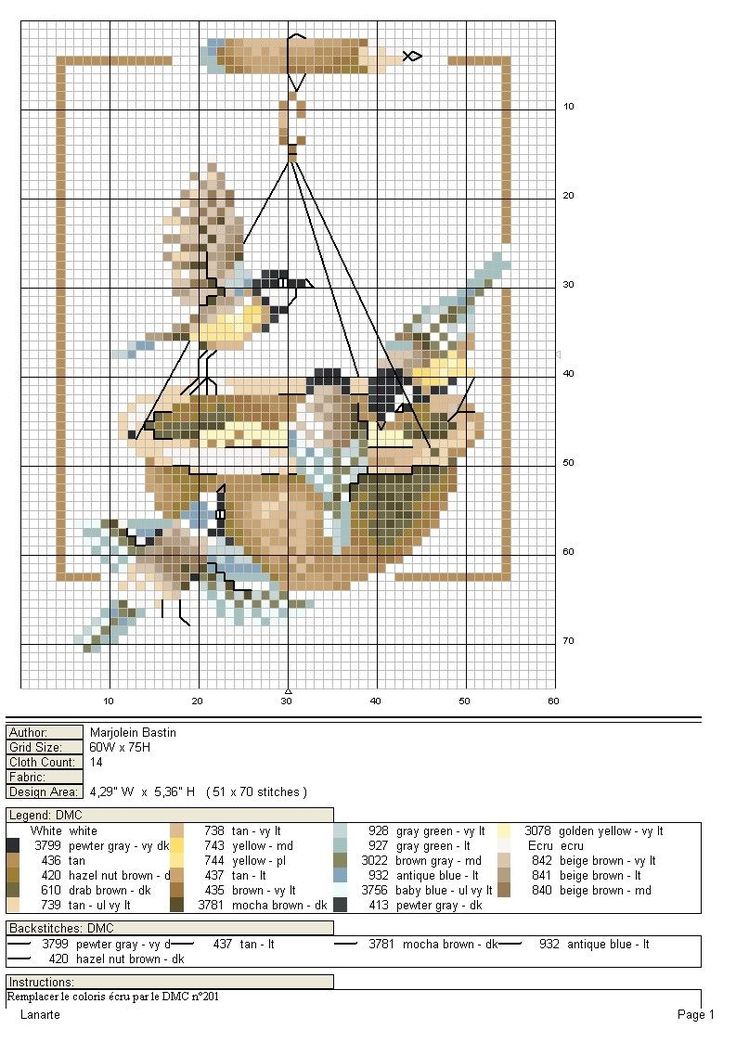 True, live food can be replaced with a surrogate as the bird grows older - transfer it to minced meat. It is enough to feed the swallow chick once an hour.
True, live food can be replaced with a surrogate as the bird grows older - transfer it to minced meat. It is enough to feed the swallow chick once an hour.
When it is clear what to feed the chicks, you need to clarify what to give them to drink and how? And most importantly, is it necessary? You can drip a couple of drops of water, introducing it further into the beak, from a pipette, but birds in the wild do not water their chicks - they have enough moisture from living food.
In order to prevent children from bringing small birds home, parents should explain to the child that fledglings - most often children bring chicks that themselves flew out of the nest, not yet fully fledged - flew out of the nest and waited for their mother, who would fed and cared for. And you don’t need to bring such chicks home, it’s better to return them to the same place so that their parents can find them. At home, feeding a chick is quite difficult.
How to feed tits at home.
 LET'S FEED TITS
LET'S FEED TITS A titmouse began to fly to my balcony, I fed it, and now five cute birds live on my balcony every day
When I have the opportunity, I watch them, this is a very interesting sight.
It turns out that these are such curious birds that there is no place on the balcony where they would not look.
They sit close to the window, stick out their head and try to look into the room through it.
Titmouse appear on my balcony very early in the morning, and fly away when it is already completely dark. You start to get used to them and every day you wait
Usually tits arrive in cities from the forest after November 12th.
In autumn they are a few shy tits, but by December all the surrounding feathered living creatures know where to feed and fly to the cities
Why is it important to feed the titmouse?
Pigeons and sparrows are common birds of the city.
They won't disappear themselves, they know how to earn their living in the city.
Tits are forest birds, and they are insectivorous.
Only fatty, high-calorie foods are suitable for them, and even then not any.
It is much more difficult for them to find food in winter.
Out of 10 tits, because of hunger, only 2 survive until spring (and in frosty winters 1-2).
Out of 10 sparrows, 10 will survive until spring (like the raven, like the doves). .
Forest birds do not know how to eat from garbage dumps, like pigeons and sparrows.
They either destroy pests, or - if there are no pests - they die.
That's why it's so important to feed them in winter: so that they live until the next spring.
Birds need to be fed regularly, because they get used to and wait, losing precious minutes that could be spent looking for food.
These are very useful birds.
Especially for those who have their own house and garden.
Do not drive away the titmouse, if it has settled with you, feed it, it will definitely answer you kindly
In places where there are feeders, titmouse simultaneously collect all wintering insects on trees, bringing great benefits to the gardener.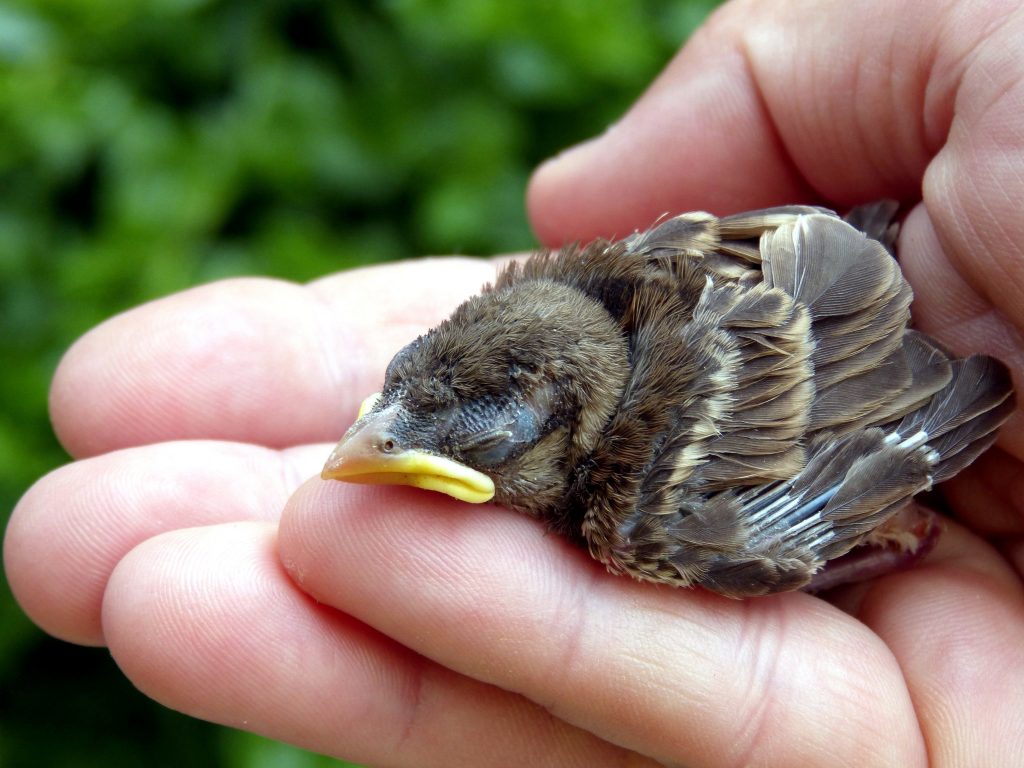
By the way, it is advisable to keep extensive hedges in the country house and near houses - birds will be happy to settle in them.
You can decorate summer cottage bushes and feed birds with delicious garlands — string nuts, berries on threads and hang these necklaces on branches.
What to feed the titmouse?
Millet and crumbs are not suitable for bird food - they are low-nutrient and tasteless, it's like putting people on a diet of crackers.
You can cook such a tasty and nutritious dish: melt a piece of fresh lard, add sunflower, melon, pumpkin, watermelon seeds, lightly crushed walnuts, peanuts, raisins, dry cherries, hop cones, chokeberry, freeze it
Delicious nutritious food is ready.
If there is no time to do this, you can give the birds all of the above seeds, unroasted seeds and nuts, grated hard-boiled egg yolk, butter and unsalted bacon (in weather -5 and colder), lightly salted cheese, cut into small cubes ( with a side of 3-5 mm).
Nutcrackers, woodpeckers will not refuse pieces of bacon hanging on twigs - unsalted raw pork. Salty lard makes birds' stomachs hurt. If you grow sunflowers, it would be nice to prepare a few heads and hang them out in the winter.
It's not too late to make a "house for a titmouse"
The simplest feeders are not at all difficult to make, it will take only a couple of minutes.
For example, take large juice bags (plastic bottles are also suitable), cut a square hole about 6 by 8 cm in size on the side, leave a 1 cm high edge on the bottom so that the food does not spill out. From above you make holes with sharp scissors, thread the rope - and that's it.
Feeder ready
Feeder options
To attract the attention of birds, you need to scatter seeds around on the snow, and hang a piece of unsalted or buttered lard, cheese nearby.
It is most convenient to hang the resulting house directly on the window or on the balcony, but then only tits will fly to you.
To admire the variety of birds, it is best to hang a bird feeder in the trees.
What does a tit chick look like. Tit chick: what does it look like and how to feed it?
Tits are one of the most common birds in our country. They are easy to find not only in forests and fields, but also in any city. Pay attention to a bird the size of a sparrow with a lemon-yellow breast, snow-white cheeks and dark blue wings - this is the very titmouse. These birds are sedentary, in autumn they rarely fly away, preferring to spend the winter near human habitation.
If you want to feed the tits, hang a piece of bacon outside the window in the feeder and sprinkle bread crumbs - the tits will be right there. But in general, these birds are insectivorous, and in wildlife their diet consists of all kinds of insects.
But what to do if a tit chick has fallen into your hands? These birds breed twice a year. The first clutch appears in April, and the second - at the end of June. Cubs grow quickly, and most often in spring and summer under the trees, here and there, a chick of a titmouse can easily be found - a fledgling. That is, the one that fell out of the nest, but has not yet learned to fly. How to distinguish it? A tit chick (you probably saw a photo of such a creature of nature) is generally similar to its adult counterparts - the same yellow breast with a dark stripe in the middle will easily help to distinguish it from other birds. Unless the color of the wings of young titmouse is not as bright as that of adults, and the plumage is softer, since it has not yet had time to change from baby fluff to real feathers. What to do with it?
Cubs grow quickly, and most often in spring and summer under the trees, here and there, a chick of a titmouse can easily be found - a fledgling. That is, the one that fell out of the nest, but has not yet learned to fly. How to distinguish it? A tit chick (you probably saw a photo of such a creature of nature) is generally similar to its adult counterparts - the same yellow breast with a dark stripe in the middle will easily help to distinguish it from other birds. Unless the color of the wings of young titmouse is not as bright as that of adults, and the plumage is softer, since it has not yet had time to change from baby fluff to real feathers. What to do with it?
Remember that if you are ready to take responsibility for a chick, then this is for life. If you, having played enough of a rescuer, fed the chick and kept it in a cage for at least a couple of days, decide to release it into the wild, with a high degree of probability it can be argued that it will die. At the same time, the content of the tit chick is completely unpretentious. It can be kept in a cage, but do not expect the bird to become tame - tits are very poorly socialized, remaining rather wild for the rest of their lives.
At the same time, the content of the tit chick is completely unpretentious. It can be kept in a cage, but do not expect the bird to become tame - tits are very poorly socialized, remaining rather wild for the rest of their lives.
By the way, these birds are often valued among canary breeders. The last birds adopt the chirping style of tits, and songbirds with this skill are especially respected. Therefore, sometimes they are placed in cages with canaries as a “singing teacher”.
How to feed a tit chick? It is best, of course, that the diet of the bird is the food that it would eat in wildlife. The best option is insects. But if this is not possible, then tits, like other representatives of songbirds (and ornithologists attribute them to this species), can be supplemented with grated boiled egg, parsley, lettuce, pre-chopped, non-acidic cottage cheese. It is most convenient to do this with tweezers. It is important to ensure that the tit chick opens its beak on its own when feeding. You can and should only feed the chicks with boiled drinking water. Caring for them is generally similar to caring for canaries, and therefore, as soon as you make sure that you have adjusted the nutrition of your new ward, consider that half the battle is already done. It remains only to feed, water, remove waste from the cage in time, and your bird will feel just wonderful and delight you with a cheerful blue tweet.
You can and should only feed the chicks with boiled drinking water. Caring for them is generally similar to caring for canaries, and therefore, as soon as you make sure that you have adjusted the nutrition of your new ward, consider that half the battle is already done. It remains only to feed, water, remove waste from the cage in time, and your bird will feel just wonderful and delight you with a cheerful blue tweet.
What grains can be fed to titmouse. What is recommended to feed tits in winter
As the most intelligent creature on the planet, a person must take care of his environment: fauna and flora. Birds are especially in need of such care in harsh and snowy winters. What to feed tits in winter and how best to do it, teachers often tell elementary school children in the classroom. But it will also be useful for adults to remember that at this time a significant number of wintering birds die from a lack of food and warmth.
Bird feeders
Feathered creatures are warm-blooded creatures that need good nutrition to maintain body temperature (+40 C). If things go badly with nutrition, then the body of the pichug will begin to cool down. The instinct of self-preservation and hunger drive the birds in search of food.
If things go badly with nutrition, then the body of the pichug will begin to cool down. The instinct of self-preservation and hunger drive the birds in search of food.
Compact feeders for titmouse and sparrows can often be found in the yards of sleeping areas and parks. Similar constructions are organized on their balconies by caring citizens.
Bullfinches, sparrows, titmouses, goldfinches, jays flock to the feeder to eat. Often in large feeders you can meet uninvited and arrogant guests - crows, jackdaws.
Bird canteens can be made by hand or purchased from a pet store. The simplest design is a plank with a roof that protects from natural precipitation, suspended from the corners of a rectangle. There are also creative ideas for creating places for feeding birds from improvised material. For example, from a milk package, a plastic container, cans.
Optimal bird diet
There is a question about the bird menu. If everything is clear with the diet of wild pigeons, it is worth learning more about the optimal filling of feeders for smaller birds.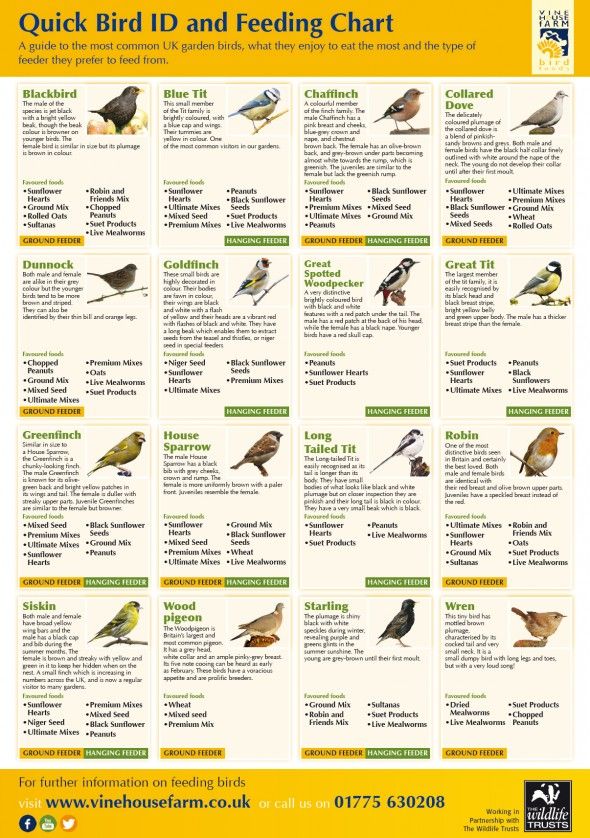
Feathered creatures are not neat. They tend to defecate while eating. That is why you should not pour a lot of food into the feeder at once, which can be spoiled very quickly. Also, do not mix feeds of different structure. For example, meat or lard should not be given along with cottage cheese.
The best food for birds is a special complex mixture, which should be purchased from specialized pet stores.
The complex composition includes seeds:
- sunflower;
- millet;
- oats;
- wheat.
Additionally, rowan fruits and bread crumbs are introduced into the bird's diet. In addition to mountain ash, you can give the birds viburnum and hawthorn berries.
If most birds are completely satisfied with such a diet, then such miniature birds as titmice should be additionally fed with fatty animal food. High-calorie food quickly saturates the tits and gives them more strength. Fat and meat act as animal and fatty foods.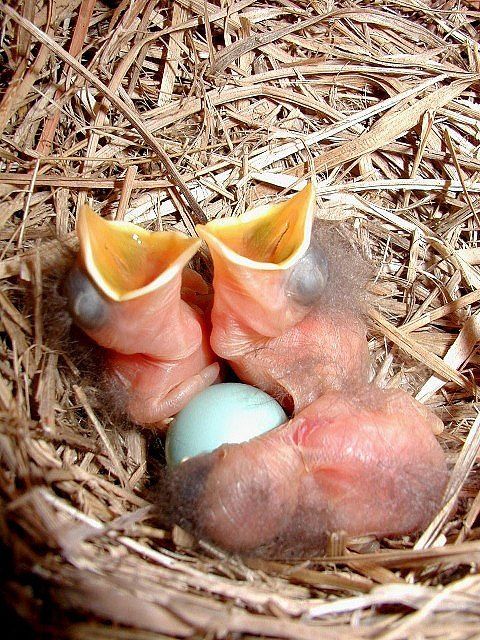 In order for the birds not to swallow large pieces, but to peck food gradually, it is recommended to string the pieces on a string in the form of beads and hang them near the feeder.
In order for the birds not to swallow large pieces, but to peck food gradually, it is recommended to string the pieces on a string in the form of beads and hang them near the feeder.
In addition, it is not necessary to encourage the development of laziness in feathered individuals. After all, if the feeders are always full of grain, they will not strain and look for a worm under the bark of trees or pick up seeds on the surface of the soil. Such conditions dull the instincts of these creatures and make them lazy and careless.
Forbidden food
Each order of birds has its own preferences. Sparrows with pigeons rarely refuse grain, and tits love seeds and lard. Birds need to be fed properly. The first rule to follow is to exclude salty foods from the diet. The peculiarity of the structure of birds is that their excretory system cannot cope with excess salt and provokes poisoning and death of birds.
Roasted sunflower seeds are banned because they can cause liver disease.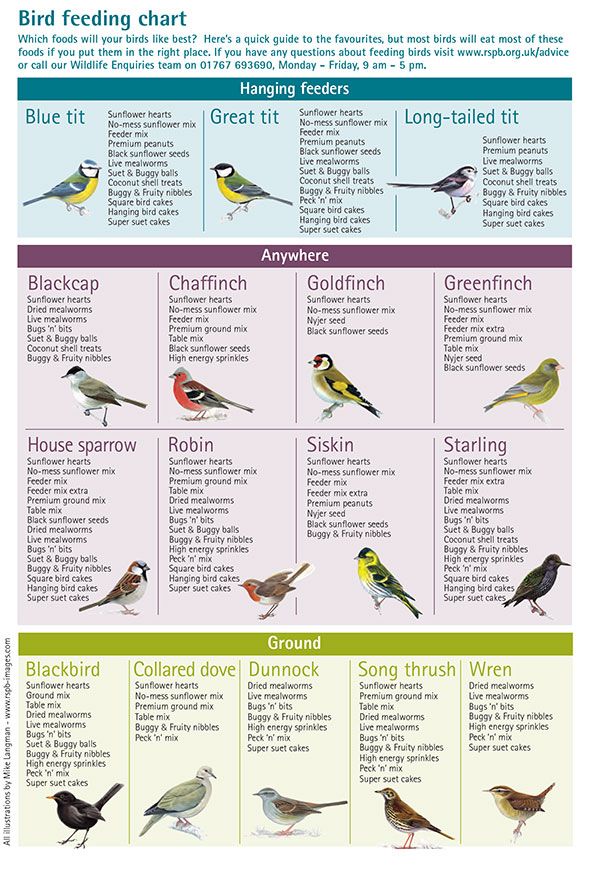 In addition, wild birds should not be given black bread and millet. Millet can become a source of toxic substances, and black bread can cause fermentation in the intestines.
In addition, wild birds should not be given black bread and millet. Millet can become a source of toxic substances, and black bread can cause fermentation in the intestines.
In addition to salty foods, do not put citrus fruits, banana peels, sour or spicy foods in the feeders.
Ordinary chewing gum is specifically prohibited. Pichugi, taking chewing gum for a tidbit, peck at the discarded gum and die from a paralyzed digestive tract.
Permissible seeds and cereals
For urban birds, the usual cereals can be considered as food. Going outside, there is no need to wonder if the birds eat rice. You can safely take a bag with millet, wheat, rice and oats with you.
In addition, birds will not refuse seeds of such vegetable crops:
- watermelon;
- gourds;
- melons;
- corn;
- sunflower.
Forest birds love cone seeds and acorns. If, going for a walk, a person took with him a small piece of white bread, then before feeding the birds, you need to crumble it.
Additionally, birds can be added to the feeder and crushed eggshells, which will become a source of calcium for them. Chopped apple pieces, cottage cheese, small pieces of raw beef can also be added to bird feeders.
How to feed the found chick, how many times a day
If you find a chick, the first thing you need to do is determine its species. Feeding granivorous, insectivorous and predatory chicks have their own differences. But in the early stages of feeding, you can use the same feeding methods, and then, after finding out what kind of bird you found, transfer the chick to the appropriate feeding.
Here is one of the most common feeding options for granivorous and insectivorous chicks. This nutrient mixture is well used for feeding for chicks and fledglings from the passerine family. To prepare our mixture, we need the following products: Boiled egg, low-fat cottage cheese, raw carrots, meat (beef, chicken, turkey), greens (lettuce, dandelion leaves, wood lice), hamarus and daphnia, Calcium gluconate (shell from boiled eggs) glycerophosphate , children's dry dairy-free porridge or boiled millet (without salt and fat on the water).
Action one. Boil the egg, free from the shell. We free the shell from the shell film. Grind the egg as much as possible, you can use a grater with small holes.
Second step. Boiled meat, it is better to take the pulp from the breast of a turkey or chicken and also chop or divide into fibers. The mixture will require meat 40 (for granivorous) and 60 grams (for insectivorous).
Third step. Take washed carrots of a small size, grate them on a fine grater, then squeeze the juice and we will use the remaining pulp.
Fourth step. We take not sour and not fatty cottage cheese. Cottage cheese should have 0% fat content, anything above is considered fat for poultry. We need 90-110 grams of cottage cheese. Sour cottage cheese must be boiled twice changing the water and then it will be suitable.
Step five. You can use greens to add the mixture, but you can do without it for the chicks. And so you can take the greens listed above, chop and add 1.5 teaspoons to the mixture.
Action six. To the above ingredients, add 1.5 -2 tsp. dairy-free porridge or boiled millet (well boiled, without salt and fat in the water).
Step seven. To the mixture we add the shell from the boiled egg, which must first be ground in a coffee grinder, plus one fourth of the crushed tablet of glycerophosphate. If it is not possible to find glycerophosphate, then you can purchase bone meal and add one fourth tsp. in powder form. At the very least, the shells are enough for now.
Step eight. We take chopped hamarus and daphnia and add about 1 tsp to the resulting mixture. Then we mix everything, it turns out a very thick, crumbly porridge, it should not stick to the fingers. If the mixture is sticky, you can add dairy-free porridge or powdered cereals.
From the resulting mixture we roll small balls no larger than a small pea, focus on the size of the chick's beak. You can feed 2-5 balls at a time and after each feeding drink plain water from an insulin syringe with a removable needle (without a needle) 4-6 drops.